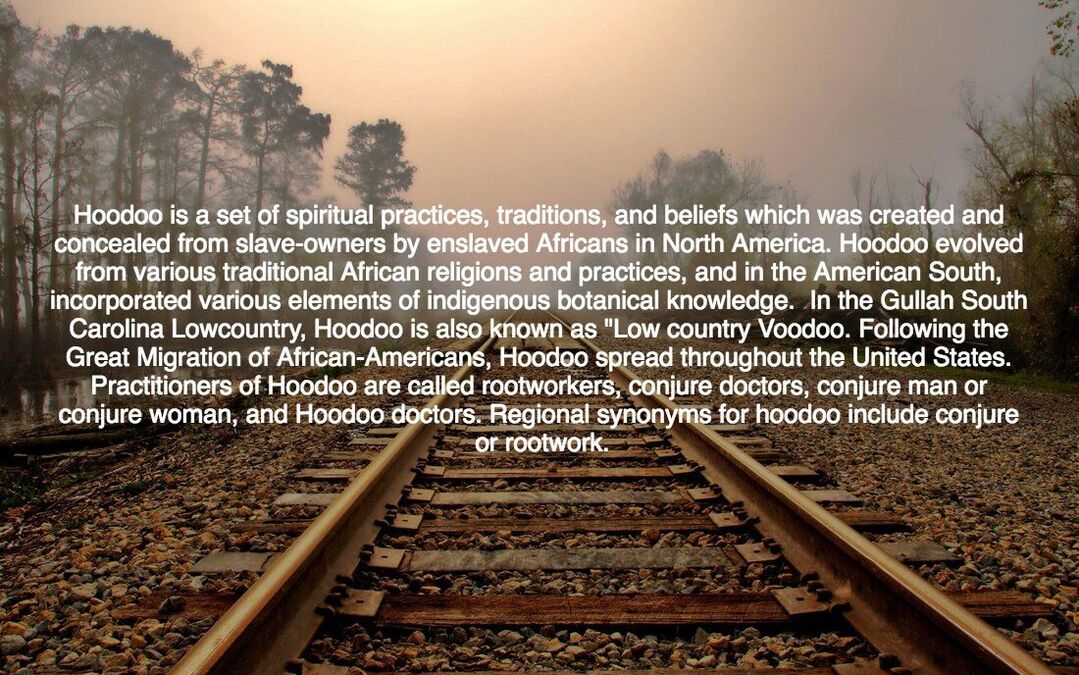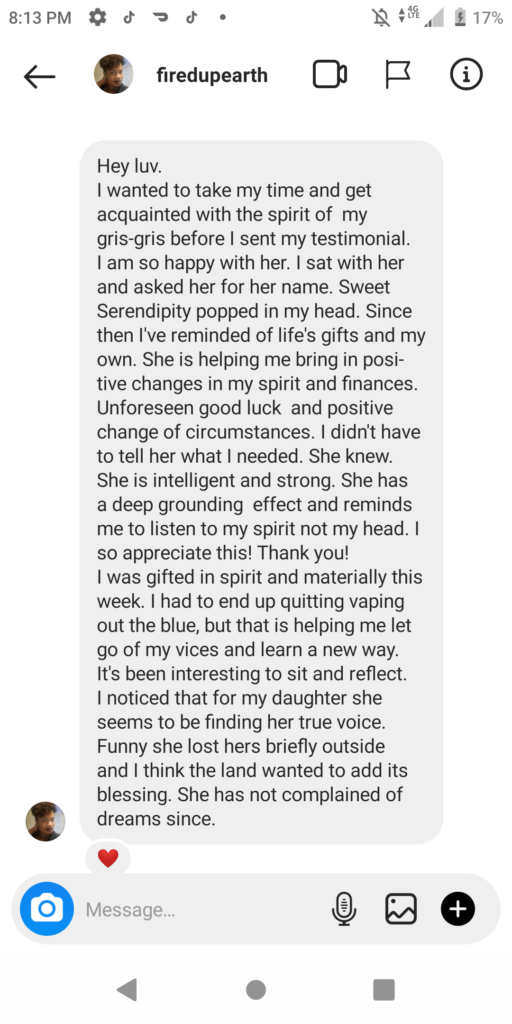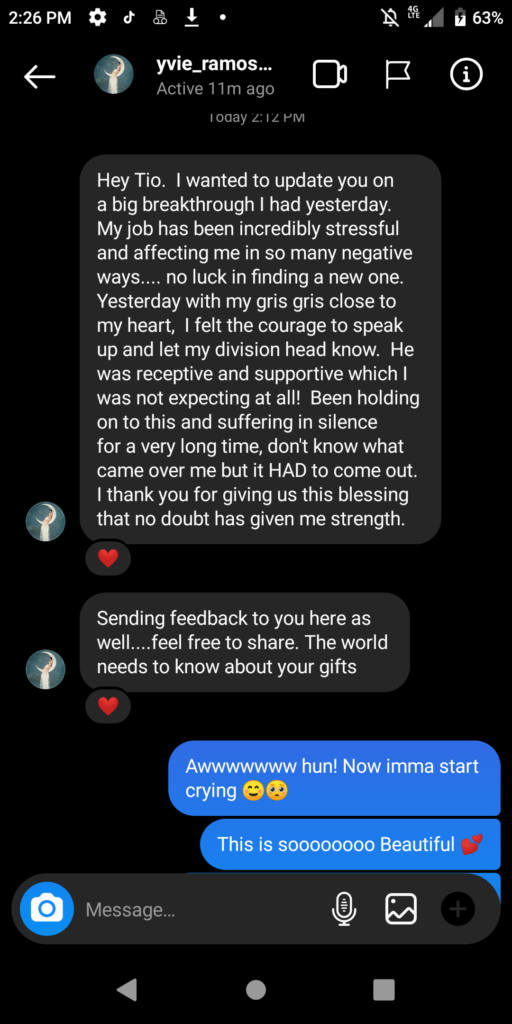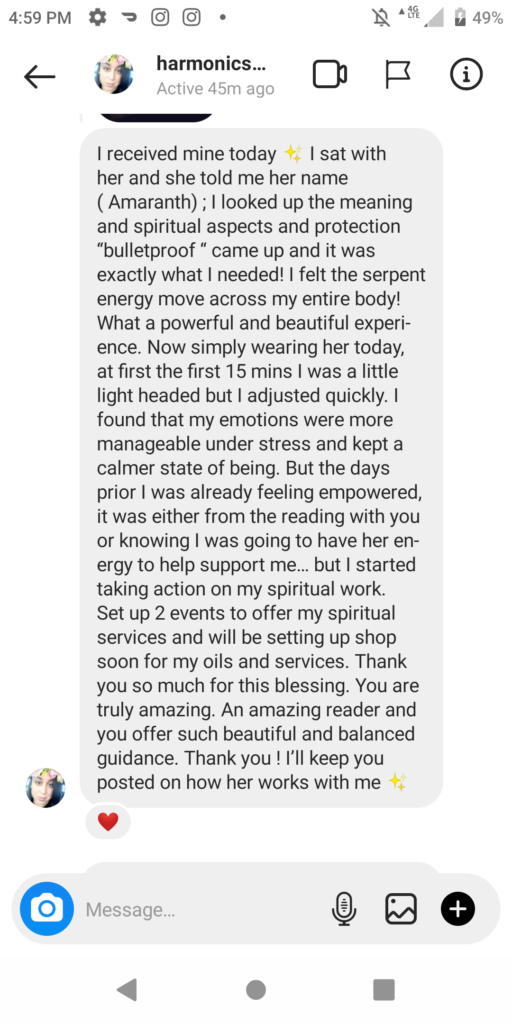WHAT IS HOODOO?
My grand pa and Grandmama, we’re all spirit people, from the bottoms of our feet to the tops of our heads, this is all we have been. For as long as anyone of us can remember, secrets have been a rootworkers greatest commodity. Our clients, friends and family, our spirit work that has healed and loved so many, its all a secret. I mean to brake that silence, the world needs to know that there is so much to be wondered at, that this world is deeply mysterious and powerful. Hoodoo is my life, has been apart of my family for hundreds of years. I am more than a show producer and a writer, I am also a Hoodoo. On this page, you will find what is in my heart and soul, Blood Brother Chronicles is filled with Hoodoo, but so is my heart.
What is Hoodoo?
Hoodoo is the set of spiritual and magical practices developed by African American slaves after being brought to America, and continued by their descendants in the American south. The enslaved Africans brought with them their own religions and magical beliefs, and had to adapt to the new land into which they were forced. The core of these beliefs still survive in Hoodoo.
The History of Hoodoo
During Slavery
African slaves in the Americas brought their religious beliefs with them. In her book, Mojo Workin’: The Old African American Hoodoo System, Katrina Hazard-Donald writes:
The major pockets of African religious expression, in Haiti, the Dominican Republic, Puerto Rico, Cuba, Brazil, Trinidad, Jamaica, and the United States black belt South, were drawn both directly and indirectly from numerous and diverse African cultures, including but not limited to Igbo, Mandingo, Bambara, Kongo, Yoruba, Fon, and Ashanti sources and would yield syncretized religious expressions such as Vodun, Santeria, Lucumi, Candomble, GaGa, Shango Baptist, Palo Mayombe (Palo Monte), Obeah, and Hoodoo.
While these religious traditions share many aspects, they are each distinct practices, and should at best be considered distant cousins that share the same ancestors.
When they arrived in the world, the African slaves were coerced into accepting Christianity. The amount and type of coercion varied depending on where the slaves were held. Slaves held in Northern areas growing tobacco, which required fewer slaves, were usually under much closer supervision than slaves working on Southern rice growing plantations, which required many more slaves.
Additionally, slaves owned by Catholics were often able to conceal their practices by calling on saints they recognized as aspects of their African divinities. Catholicism also introduced the use of Holy Water and blessed oils into Hoodoo.
Slaves owned by Protestants had no such outlet and were forced to keep their practices more secretive. Because of this, Hoodoo should be seen not just as a spiritual or magical practice, but also as a form of resistance against White spiritual domination.
African slaves were cutoff from their traditional knowledge of roots and herbs from their home lands and had to adapt. Interactions with Native Americans increased their knowledge of the healing herbs of their new homes.
“Root doctors”, who knew about the medicinal properties of roots, were sought out for medical ailments because slaves did not have access to the White man’s medical system. Knowledge of local roots and herbs could alleviate many problems, making root doctors highly respected in their communities.
Conjurers were people who knew about the spiritual and magical properties of roots, and helped provide security and protection stemming from the violence that slaves endured. Hoodoo spells, called workings, existed for a large number of purposes, from calming the anger of slave owners to helping a slave focus on their work. The Conjurer, treater, two head, root doctor, or just Hoodoo, as root workers were also known, served as a bridge between the community and the wider spirit world.
After Emancipation
After the Civil War, freed slaves in the South found themselves surrounded by a culture of oppression. Work was often difficult to find and the lives of African Americans were held in low regard. Faced with this, many decided to move from rural areas to larger urban areas, both in the South and in the North.
Moving away from their communities cut many African Americans off from their traditional access to Hoodoo root workers. It wasn’t long before offers for Hoodoo roots and spells began appearing in publications aimed at African Americans. Many of these products were created by White profiteers with little regard for the traditional production of things like mojo bags, and the quality of the products was dubious, at best.

Additionally, these products were often marketed along side other “magical” items that descended from non-African practices, such as astrology, tarot cards, and kabbalah.
Without access to the natural roots and herbs needed for traditional Hoodoo practices, many turned during this period towards the use of candles and oils. Candles had rarely been used by African slaves due to their cost and lack of availability. Magical oils were useful because a little bit of root could be “stretched” by conveying it’s properties into the oil. Candles and oils were also easier to market, because they were easier to ship and store.
Hoodoo Beliefs
The African cultures from which Hoodoo descended shared aspects such as reverence for ancestors, the belief that the natural world is full of spirits, and that the earth itself is a source of power. These aspects are still the core of Hoodoo.
Respect for Ancestors
Hoodoo practitioners revere their ancestors and pay them respect in the form of offerings. These offerings can take place at an ancestral altar in their homes or at a graveyard. Offerings can include the burning of candles, bits of food or alcohol like whiskey, prayers, and incantations. Hoodoo understands that by respecting our ancestors, those ancestors can intercede in the physical world on our behalf.

The Natural World is Full of Spirits
Every tree, plant, and rock contains spirits that can be called on to aid us. Hoodoo practitioners are often called Root workers because so much of their work involves herbs and roots. Hoodoo herb lore extends over hundreds of years and includes knowledge about which roots can help a person find love, which can draw money to you, which can protect you from evil, and even those that can hex an enemy. The powerful spirits in herbs in roots can be used in oils, baths, floor washes, to dress a candle, or in a mojo bag.

The Earth Is a Powerful Source of Magic
The Earth itself contains an immense source of magic that can be tapped into. Earth from different locations absorbs the energy of that place. For instance, a mojo bag may be buried in the ground near a bank to increase its ability to draw money to the wearer, while earth from a river bank has powerful spiritual cleansing properties. Earth from a graveyard or a crossroad is considered incredibly powerful, and is used in many Hoodoo spells.

Hoodoo is not a religion, like Voodoo or Santeria. Since there is no hierarchy in Hoodoo, its practices vary from region to region, and even from person to person. This also means that anyone can practice Hoodoo, as long as the three main principles described above are adhered to.
Hoodoo Magic
Hoodoo magic is called Rootwork or Conjure. The name Rootwork is derived from the use of herbs and roots, and along with other sacred items, to create change in the physical world.
Bathes and Washes
Spiritual baths and washes are used for diverse needs, from purification and cleansing to drawing luck and prosperity. All of the African religious practices from which Hoodoo descends practiced immersion in water, and the integration of Christian practices including baptism and Holy Water have only added to the importance of water in Hoodoo.
A spiritual bath is one in which a person is immersed in water containing herbs or roots. When used as a form of cleansing, water is usually washed downward, from head to toe, to remove any spiritual contamination, such as a hex. When used to draw luck or money, the washing is done in the opposite direction, as if pulling the desired item towards the person.
Floor washes are used in much the same manner, but are applied to a person’s home or business. They are often made with similar ingredients to a spiritual bath, but are applied with a mop to the floor of a dwelling. If used for cleansing the house is usually cleaned from inside to out, to push evil out from the house. If used to draw something towards the home or business, for instance to attract customers, the floor wash is applied outside-in. The wash is often done in a counter-clockwise direction, reminiscent of ancient African spiritual dances.
Mojo Bags
A mojo bag, also called a hand, a gris-gris, or a toby, among other names, is used to carry the power of roots around with a person. The preparation, ingredients, and position where worn on the body vary greatly among practitioners and according to the purpose of the bag.
Mojo bags were traditionally made of leather, but in the modern era are most often made of flannel. Some practitioners modify the color of the mojo bag to reflect the purpose of the bag; for instance, red for power or strength, green to draw money or luck, or purple for spiritual or psychic clarity.
Part of the preparation of a mojo bag may including burying it at a place related to its purpose, to draw in the spirits of that place. For instance, mojo bags intended to draw money may be buried at a bank for a short time before use, while a mojo bag used for spiritual protection may be buried outside a church.
Items from a targeted person may be added to a mojo bag as well. Hair, fingernails, spit, urine, or blood may be used. This acts as a way finder for the spirits of the mojo bag, to ensure they know who the working is for.
Earth
Different types of earth, or dirt, play important roles in Hoodoo. As mentioned before, earth from a graveyard or crossroads play a role in many Hoodoo magic spells. Additionally, dirt from locations that have absorbed spirits of the place may be used in mojo bags, or even spiritual baths or washes.
Candles
Thought not found in Hoodoo during the days of slavery, the use of candles in Hoodoo grew during the migration of freed African Americans to urban centers in the both the South and the North.
Candles are used to feed the spirits of ancestors, and the spirits of the roots, by giving them light and smoke. They are often burnt during the creation of mojo bags or during other magical spells, as well as during spiritual baths or washes.

Candles, like mojo bags, come in a variety of colors that represent their use. They are also often dressed with conjure oil containing roots and herbs to provide more “direction” to the spell.
Candles are also used in divination in Hoodoo. After spell work has been completed, the way the wax spreads can be interpreted to see if it will be successful.
Conjure Oils
Oils prepared with Hoodoo roots are often easier to work with than the roots themselves. They can be applied to mojo bags, used in spiritual washes and baths, or simply used to anoint the Hoodoo practitioner.
Conjure oils are often given a name to indicate their use, such as Money Draw Oil to bring prosperity, Come to Me Oil for attraction, or Uncrossing Oil to set matters right again.
Hoodoo Today
There is a growing interest in Hoodoo in the United States, as people find themselves looking for spiritual answers without turning towards a structured religion. Hoodoo, thanks to its long history of retaining ancient African spiritual knowledge, is seen as a practice that is untainted by modern “magical” marketing. And since there is no hierarchy to Hoodoo, anyone can get started and adopt aspects of it that appeals to them: its spiritual practices like respect for ancestors, or its magic like rootwork.
You can get started in Hoodoo by respecting the core beliefs mentioned above, and get started in rootwork with many roots and herbs you’ll find are already in your house.
Theodore Beaulieu – Old World Hoodoo In A Modern Age
Hoodoo has been in my family for seven generations, this is our way of taking care of our community for generations. From taking care of our health, because many of us ere not allowed in hospitals because of segregation, to bringing families together, Hoodoo Gris-gris are a staple to our practice. I am very happy to be able offer our old ways to my own community.
Pronounced ‘gree-gree’, are also known as a mojo bags and a favorite in New Orleans Voodoo, they are portable Hoodoo amulets and is usually worn on the person. They contain a mixture of herbs, oils, stones, bones, hair, graveyard dirt, or other personal items. Each gris-gris is hand-made and cultivated by Theodore Beaulieu with a specific purpose: Love, lust, attraction, prosperity, good luck, peace, harmony, protection, health, vengeance and revenge, or whatever your heart desires…

Taking care of your Gris-gris.
A gris-gris is a spirit, and like all spirits your gris-gris needs tender love and care. Below are instructions on ho to take care of your gris-gris.
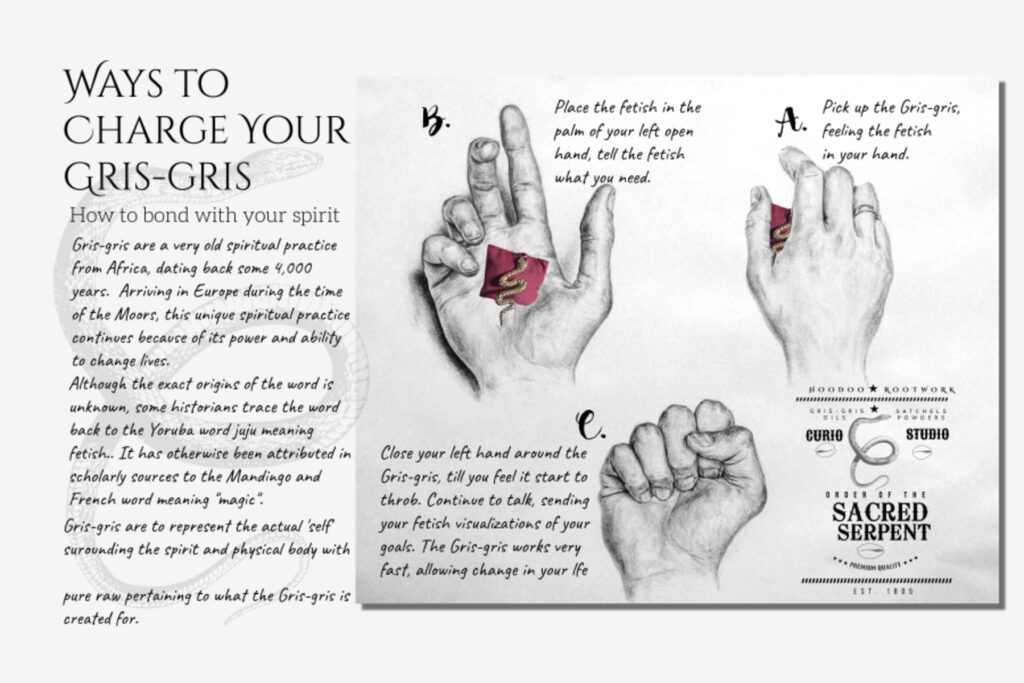
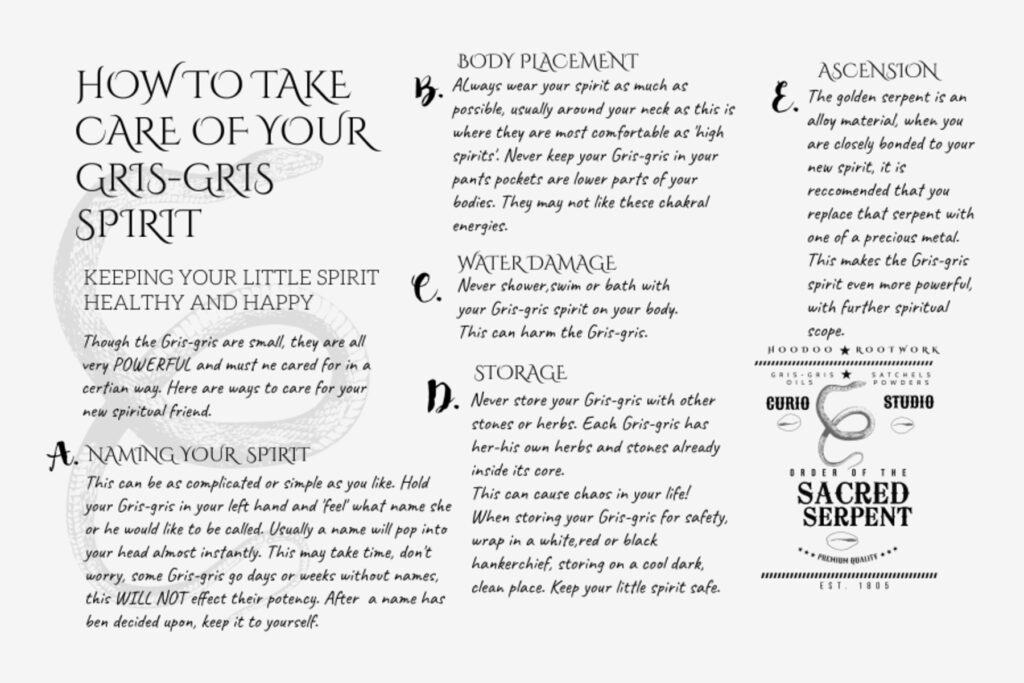
Products
Hoodoo, at its core, is an African American tradition. It was created by enslaved people from various spiritual practices that they adapted to the land they found themselves in. Hoodoo is also known by other names, mainly conjure or rootwork. People who practice Hoodoo work with a number of tools, such as candles, curios, and, of course, roots and herbs. Ancestor veneration is particularly important. Below are conjured gris-gris created by Theodore Beaulieu, for all types of situations.
[ecwid widgets=”productbrowser” default_category_id=””]Testimonials
Below are just a few of many testimonials received concerning Theodore’s powerful gris-gris. Change your life for the best, experience TRUE Louisiana mojo
